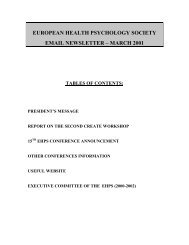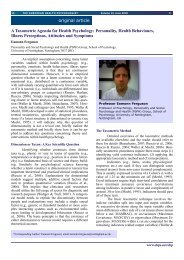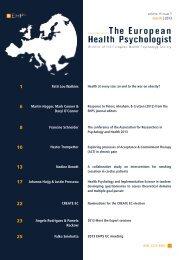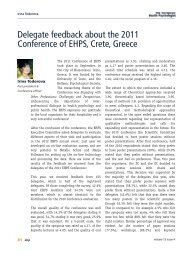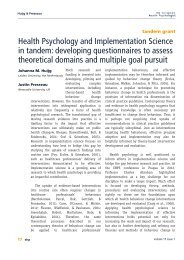PDF download entire issue - European Health Psychology Society
PDF download entire issue - European Health Psychology Society
PDF download entire issue - European Health Psychology Society
Create successful ePaper yourself
Turn your PDF publications into a flip-book with our unique Google optimized e-Paper software.
www.ehps.net/ehp<br />
time-sampling in health psychology<br />
activity for the purpose of being ‘good’ patients<br />
or research participants. If researchers are<br />
concerned that their study may elicit socially<br />
desirable responding then they might want to<br />
add a control group or consider pairing selfreport<br />
based time-sampling with concurrent<br />
objective measures. For instance, it is possible to<br />
combine daily self-reports with different kinds of<br />
ambulatory devices, such as heart rate monitors<br />
or accelerometers to gauge physical activity, or<br />
to implement supplementary measures as is<br />
often done by using saliva samples, for example,<br />
to assess stress-related substances such as<br />
cortisol (Hoppmann & Klumb, 2006; Hoppmann<br />
& Riediger, 2009). Another important feature is<br />
represented in the fact that time-sampling takes<br />
research out of the lab into individuals’ real<br />
world environments, thus maximising the<br />
ecological validity of health psychological<br />
research employing such methods (Feldman-<br />
Barrett & Barrett, 2001). Hence, there are many<br />
available options for complementing self-report<br />
based time-sampling protocols using additional<br />
devices and this can be done in an ecologically<br />
valid fashion.<br />
Researchers can draw on a broad spectrum of<br />
assessment methods ranging from daily phone<br />
interviews and paper diaries to pager-prompted,<br />
pocket computer, or cell phone assessments<br />
when conducting time-sampling research<br />
(Hoppmann & Riediger, 2009). All of these<br />
approaches offer unique insights into healthrelated<br />
processes and they all have their specific<br />
benefits and pitfalls (Bolger, et al., 2003).<br />
Therefore, time-sampling methods should be<br />
chosen based on the targeted phenomenon and<br />
the specific study population. For example,<br />
pocket computers may be the data collection<br />
tool of choice if the best assessment of a specific<br />
phenomenon involves the administration of<br />
timed tasks, random schedules, or branched<br />
questionnaires. Although still novel, pocket<br />
computers have been used successfully in many<br />
december | 2011<br />
different populations including older adults and<br />
various patient populations. However,<br />
computerized assessments also pose minimum<br />
requirements regarding cognitive functioning<br />
and sensory-motor skills that render them<br />
unsuitable for certain patient populations<br />
(Hoppmann & Riediger, 2009). In this scenario,<br />
other tools such as daily telephone interviews<br />
may be the assessment method of choice<br />
(DeLongis & Holzman, 2005). Researchers can<br />
therefore choose from a broad array of different<br />
time-sampling tools to examine daily life<br />
processes that ought to be selected based on the<br />
specifics of the research question and the<br />
targeted population.<br />
Novel health psychological questions best<br />
addressed by time-sampling research<br />
In <strong>Health</strong> <strong>Psychology</strong>, there are several<br />
research questions that would particularly<br />
benefit from an implementation of timesampling<br />
methods. For example, time-sampling<br />
methods allow researchers to take health<br />
psychological research out of the lab and into<br />
individuals’ daily life environments. Hence, intraindividual<br />
variability in thoughts, behaviours,<br />
and feelings across different daily life situations<br />
is not treated as a nuisance. Instead, changing<br />
characteristics of momentary circumstances<br />
become a key part of the phenomenon under<br />
study (Almeida, 2005; DeLongis & Holzman,<br />
2005). Importantly, by investigating interindividual<br />
differences in intra-individual<br />
variability, health psychological research may<br />
elucidate the complex interplay between the<br />
person and the situation. For example, it has<br />
been shown that individuals high in Neuroticism<br />
(inter-individual differences) encounter more<br />
daily life stressors than individuals low in<br />
Neuroticism and that the former also react more<br />
strongly to daily life stressors (situationspecificity)<br />
than the latter (Bolger & Zuckerman,<br />
1995). Time-sampling research thus provides<br />
means of addressing research questions that<br />
ehp 66



